中国建筑英文介绍PPT课件
- 格式:ppt
- 大小:7.94 MB
- 文档页数:13
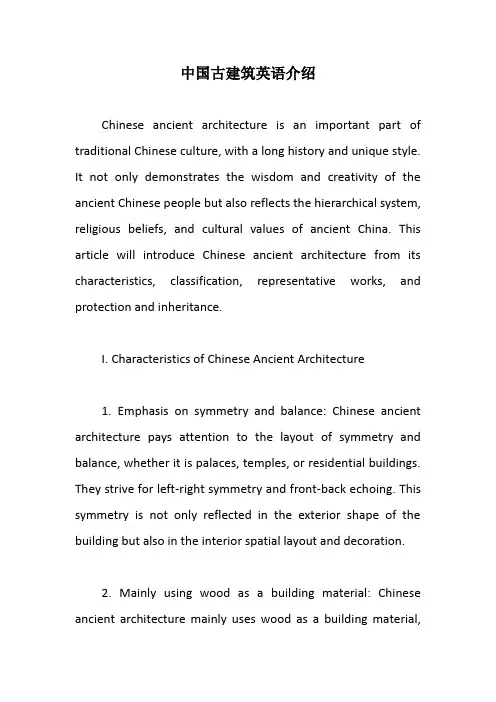
中国古建筑英语介绍Chinese ancient architecture is an important part of traditional Chinese culture, with a long history and unique style. It not only demonstrates the wisdom and creativity of the ancient Chinese people but also reflects the hierarchical system, religious beliefs, and cultural values of ancient China. This article will introduce Chinese ancient architecture from its characteristics, classification, representative works, and protection and inheritance.I. Characteristics of Chinese Ancient Architecture1. Emphasis on symmetry and balance: Chinese ancient architecture pays attention to the layout of symmetry and balance, whether it is palaces, temples, or residential buildings. They strive for left-right symmetry and front-back echoing. This symmetry is not only reflected in the exterior shape of the building but also in the interior spatial layout and decoration.2. Mainly using wood as a building material: Chinese ancient architecture mainly uses wood as a building material,such as beams, columns, purlins, and brackets. Wood has good plasticity and toughness, is easy to process and install, and also has good thermal insulation performance.3. Rich and diverse roof shapes: The roof shapes of Chinese ancient architecture are rich and diverse, such as hip roof, gable roof, suspended roof, and winged roof. These roof shapes not only have practicality but also strong decorative features, reflecting the aesthetic concept of ancient Chinese architecture.4. Carving and painting art: The carving and painting art of Chinese ancient architecture is rich and colorful, such as woodcarving, brick carving, stone carving, and murals. These carved and painted works are both decorative and symbolic, reflecting information about ancient Chinese society's politics, economy, culture, etc.5. Color application: The color application of Chinese ancient architecture emphasizes harmony and contrast, mainly using red, yellow, green, blue, etc. as the main color scheme. Red represents joy, auspiciousness, yellow represents royalauthority, green represents life and hope, blue represents the sky and the sea. The use of these colors not only reflects the aesthetic concept of ancient Chinese architecture but also reflects the cultural values of ancient society.II. Classification of Chinese Ancient Architecture1. Palace architecture: Palace architecture is the place where ancient Chinese emperors lived and handled political affairs, such as the Forbidden City in Beijing and the Shenyang Imperial Palace. These palace buildings are large in scale, majestic in momentum, and have high historical, artistic, and scientific value.2. Temple architecture: Temple architecture is the place where ancient Chinese people worshipped gods and ancestors, such as Tai Mountain Dai Temple and Songshan Shaolin Temple. These temple buildings usually have a solemn and respectful atmosphere, reflecting the ancient people's awe towards gods and ancestors.3. Garden architecture: Garden architecture is the placewhere ancient Chinese people leisured, visited, and enjoyed natural landscapes, such as Suzhou Humble Administrator's Garden and Hangzhou West Lake. These garden buildings focus on creating landscapes of mountains and rivers, emphasizing the harmonious coexistence between humans and nature.4. Residential architecture: Residential architecture is the place where ancient Chinese common people lived, such as Beijing Siheyuan and Shanxi Pingyao Ancient City. These residential buildings have distinct regional characteristics and ethnic styles, reflecting the living habits and cultural traditions of ancient people.5. Religious architecture: Religious architecture is the place where various religious beliefs in ancient China were practiced, such as Buddhist temples and Taoist palaces. These religious buildings usually have high artistic value, such as the Mogao Grottoes in Dunhuang and Longmen Grottoes.III. Representative Works of Chinese Ancient Architecture1. The Forbidden City: Located in the center of Beijing, it isthe imperial palace of Ming and Qing Dynasties in China and also the largest existing wooden structure ancient architectural complex in the world. The Forbidden City is famous for its grand architectural scale, exquisite carving art, and rich collection of cultural relics.2. The Great Wall: Located on the northern border of China, it is a military defense project built by ancient China to defend against northern nomadic invasions. The Great Wall is about 23,000 kilometers long, making it the longest wall in the world and known as the "Ten Thousand Li Great Wall."。

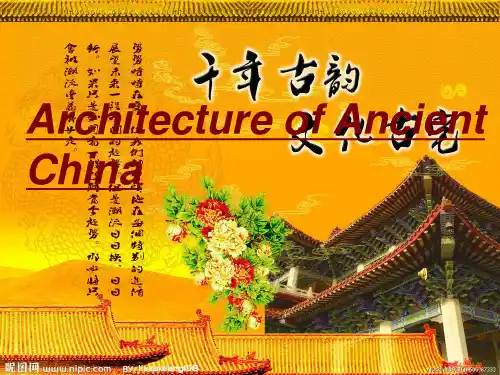

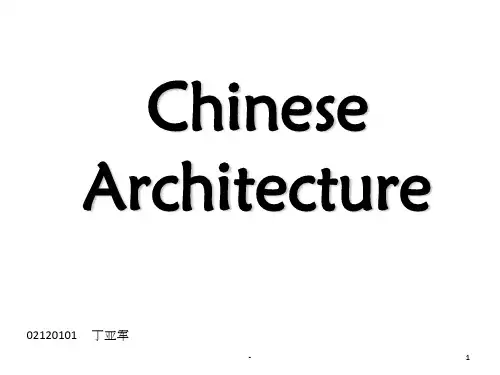

![中国建筑英文介绍[优质ppt]](https://uimg.taocdn.com/8e54f89ed5bbfd0a795673ea.webp)

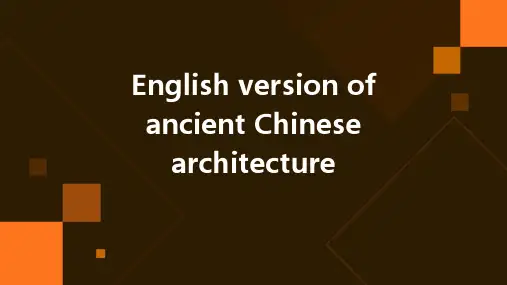
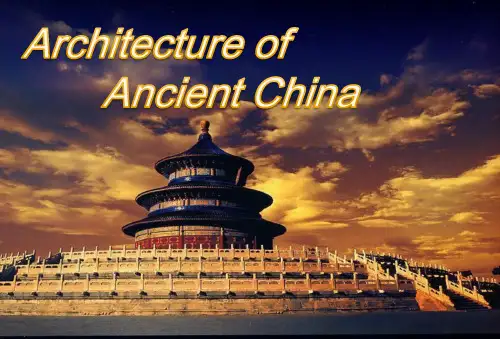

Chinese Famous Architecture: An Introduction Chinese architecture has a rich history that dates back thousands of years. From ancient temples to modern skyscrapers, China boasts a diverse range of remarkable architectural treasures. In this article, we will explore some of the most renowned Chinese architectural masterpieces.The Great Wall of ChinaThe Great Wall of China is an iconic symbol of Chinese civilization and one of the world’s most famous architectural wonders. Extending over 13,000 miles, it was built to protect the Chinese empire from invasions. Made of stone, brick, tamped earth, and other materials, the Great Wall stands as a testament to the ingenuity and determination of the Chinese people.The Forbidden CityLocated in the heart of Beijing, the Forbidden City served as the imperial palace for over 500 years. With its intricate design, grand halls, and beautiful gardens, it showcases the brilliance of traditional Chinese architecture. The Forbidden City is a UNESCO World Heritage site and a popular tourist destination, offering visitors a glimpse into China’s imperial past.The Terracotta ArmyDiscovered in 1974 near Xi’an, the Terracotta Army is an extraordinary archaeological find. The army consists of thousands of life-sized terracotta soldiers, horses, and chariots that were buried to protect Emperor Qin Shi Huang in the afterlife. Each soldier has distinct facial features, reflecting the remarkable craftsmanship of the ancient Chinese artisans.The Temple of HeavenThe Temple of Heaven is a masterpiece of Ming Dynasty architecture located in Beijing. It was a place where emperors of the Ming and Qing dynasties would come to pray for good harvests. The complex includes the Hall of Prayer for Good Harvests, the Imperial Vault of Heaven, and the Circular Mound Altar. Its harmonious design and exquisite details make it a prime example of traditional Chinese religious architecture.The Shanghai TowerAs a modern architectural marvel, the Shanghai Tower dominates the city’s skyline. With its 128 floors reaching a height of 2,073 feet, it is one of the tallest buildings in the world. The tower’s unique design features a twisting exterior thatreduces wind load and contributes to its structural stability. The Shanghai Tower is a symbol of China’s rapid urbanization and technological advancemen t.The Lingering GardenThe Lingering Garden in Suzhou is a classical Chinese garden renowned for its poetic beauty and tranquil atmosphere. It was built during the Ming Dynasty and captures the essence of Chinese garden design principles. The garden features a harmonious blend of pavilions, rock formations, water features, and meticulously arranged plants. It is a UNESCO World Heritage site and a popular destination for those seeking serenity in nature.The Yellow Crane TowerThe Yellow Crane Tower is a historic tower located in Wuhan. Originally built in the 3rd century, it has been rebuilt and renovated multiple times throughout history. The tower offers breathtaking views of the Yangtze River and the cityscape. It has served as an inspiration for countless poets and artists, becoming an enduring symbol of Chinese culture and literary excellence.ConclusionChinese architecture is a testament to the country’s rich history, cultural depth, and architectural achievements. From ancient wonders like the Great Wall of China and the Terracotta Army to modern marvels like the Shanghai Tower, these architectural treasures represent the ingenuity, artistry, and cultural significance of China. Exploring these iconic structures is a truly immersive experience that allows you to appreciate the beauty and grandeur of Chinese architecture throughout the ages.。